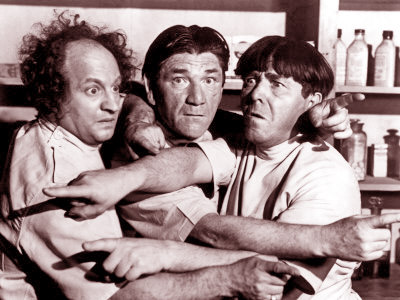
Since everyone's talking these days about the Three Stooges, I think it's time I owned up to something. In over 45 years of blogging here, I have posted no more scandalous, controversial opinion than the one I'm about to confess to you: I like Shemp. Matter of fact, I think I like Shemp more than I like Curly.
Now, I have to qualify that. I generally like the shorts with Curly more than the shorts with Shemp. If I ever took the time to list my ten favorite Stooge shorts, most if not all would contain Curly…but that's judging the films, not the Third Stooges in them. The history of the Three Stooges shorts is pretty much an ongoing question of "How cheap can we make them for this year?" The Stooges starred in 190 short comedies for Columbia between 1934 and 1959. During those years, the popularity of two-reel short comedies declined to the point where most studios eventually abandoned the form completely. Laurel and Hardy, for example, stopped making shorts in 1935, getting out just as the Stooges got in.
As more and more studios gave up on two-reelers, the Columbia shorts department filled whatever marketplace remained, not just with the Stooges but with a lot of comedians whose careers were on the downside like Buster Keaton, Charley Chase, Andy Clyde and Harry Langdon. Eventually though, it was just Moe, Larry and the current Third Stooge. Their budgets got lower and lower with fewer (eventually, no) exteriors, less elaborate visual gags, smaller casts and — most of all — increasing reuse of old scripts and old footage. Some of the last Stooge shorts were actually shot in one day, filming a few minutes of new stuff to edit into an old film so they could pass it off as a new one.
When I first discovered the Stooges, it was on a local Los Angeles channel — KTTV, Channel 11. A man named Don Lamond, who happened to be Larry's son-in-law, hosted an afternoon show that fluctuated in length. Sometimes, it was an hour and they'd run three shorts in an hour. Sometimes, it was a half-hour and they'd cram in two, which required serious editing since most of those shorts were originally 16 minutes long. By the time they hacked out room for the commercials and for Mr. Lamond, the 30-minute Three Stooges show was running two ten-minute episodes. The films seemed to be selected at random and once in a while, I'd find myself watching a film that contained a long sequence that I'd just seen in the film before it. Once, back to back, they ran Corny Casanovas (with Shemp) and Rusty Romeos (with Joe Besser), which are basically the same film. They made it with Shemp in 1952 and then in 1957, they just reshot Shemp's scenes with Joe and issued it as a new film.
So there was this decline in budgets and shooting time and everything and that's one reason I think Shemp doesn't get his due though he was a better comedian than Curly. Matter of fact, I think Joe Besser was a better comedian, too. They both had to work with weaker material than Curly. They both had to work at a faster pace, shooting many more pages per day. But I think they elevated those films by having a wider range of reactions. Curly was fine in short doses but he had about three expressions and six noises and once he'd made all those expressions and noises, he was done for me. Part of the reason for his popularity I think is that he was the Third Stooge who got to appear in the shorts that weren't made for eleven dollars.